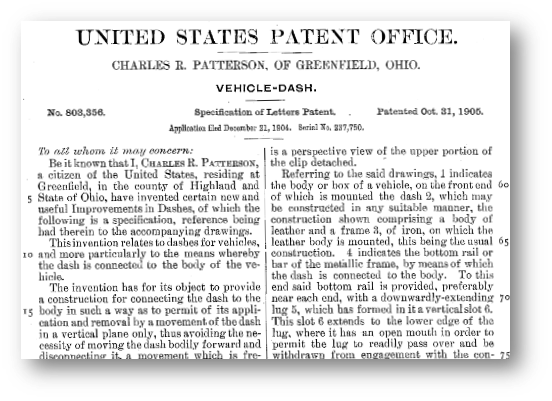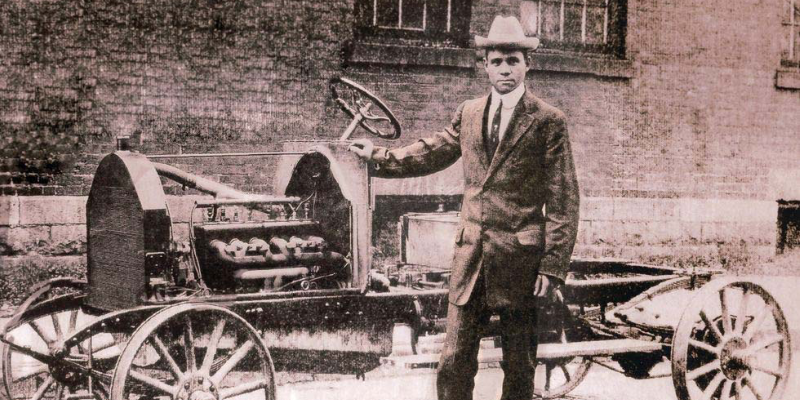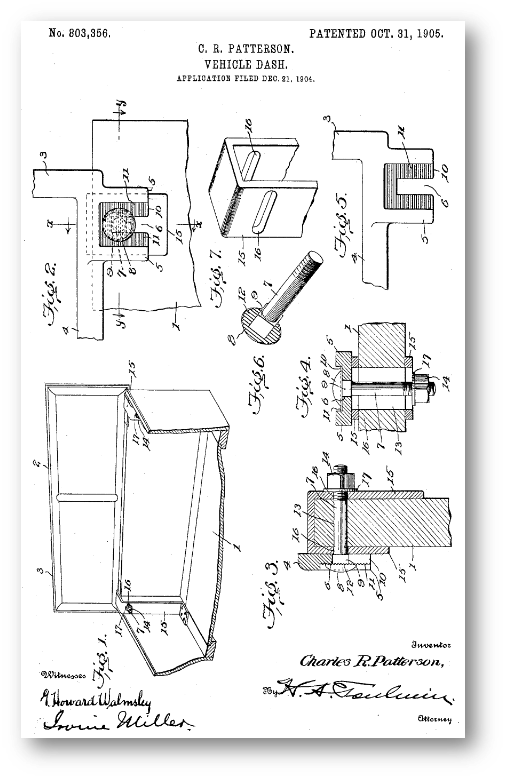| By Chilton Staff |
Charles Richard (C. R.) Patterson was born in 1833 in Virginia. Accounts differ as to whether his family was enslaved or free. In 1840, he and his parents and three of his brothers escaped or traveled to Greenfield, Ohio, a stop on the Underground Railroad. According to Patterson family lore, the family swam across the Ohio River. C. R. would have been 7 or 8 years old at the time.1
When the family arrived in Greenfield, “horseless carriages” had not been invented. People rode in horse-drawn wagons and carriages. Yet C. R. was destined to found the company that would become the first Black-owned American automobile manufacturer.
Initially, C. R. worked as a blacksmith, earning a reputation for expert craftsmanship. In 1865, he started a company, C. R. Patterson, while working on other projects as well. During these years, Patterson received a handful of patents, including a patent for a vehicle dashboard in 1905.

Excerpt from the United States Patent and Trademark Office.
Horseless carriages, or “automobiles” as they came to be called, were becoming popular in the early 1900s. It was a time when hundreds of individuals and companies were building cars. As automobiles proliferated, C.R. Patterson & Sons began repairing them as well.
C. R.’s college-educated son, Frederick Douglass Patterson, saw that automobiles were the future. In 1910, he began preparing to build high-quality, handmade roadsters and touring automobiles. In Greenfield, many of the workers were farmers and much of the work was done in the winter months, when workers were available.
In September 1915, C.R. Patterson & Sons released its first automobile, the Patterson-Greenfield. The venture was short lived because, as Ford began assembly-line mass production, it became difficult for smaller companies to compete. C.R. Patterson & Sons released its last vehicle in 1918. Hundreds of automobile manufacturers failed or were absorbed by other companies in these early years of automotive history.
C.R. Patterson & Sons continued servicing and repairing automobiles and also began building commercial and bus bodies. When sales dried up during the Great Depression, after 74 years, the company closed its shop in 1939.
For their remarkable accomplishments while facing ostracism, prejudice, and other obstacles, on July 22, 2021, both C. R. Patterson and his son Frederick Douglass Patterson were inducted into the Automotive Hall of Fame,2 one of the highest honors in the automotive industry.
With vehicle data back to the 1940s, ChiltonLibrary is a valuable source of trusted automotive information. Not a subscriber? Contact your Gale consultant today or request a free trial.
Recommended Reading
- Greenfield Historical Society. “The Patterson Automobile.”
- May, Henry A. First Black Autos. New York: Stalwart Publications, 2006.
- Nelson, Christopher. The C.R. Patterson and Sons Company, second edition. Independently published, Amazon, 2022.
- The Smithsonian National Museum of African American History and Culture. “The Only African American Automobile Company.”
- Tate, Robert. “C. R. Patterson & Son Fred, 1st African American Carmakers.” MotorCities National Heritage Area, November 7, 2018.


